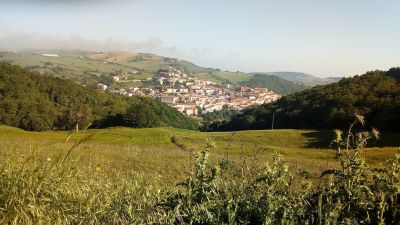Il Comune di Bonefro in provincia Campobasso, è situato sui pendii della Regione Molise, nell'Italia centrale. La forte emigrazione verso gli Stati Uniti che ha colpito le zone più povere della penisola tra la fine dell'800 e l'inizio del '900, non ha risparmiato questa cittadina, che ha sofferto le cause di un fortissimo spopolamento. In anni più recenti, l'intera zona è anche stata vittima di un violento sisma, che ha causato danni ingenti ad una economia ed una comunita già fortemente provate. La tenacia e la forza di volontà dei cittadini hanno però portato una faticosa ma graduale ricostruzione, un conseguente ripopolamento della cittadina ed il fiorire di nuove attività commerciali.
The little Italian village of Bonefro lies in the gentle hill country of the Molise region of central Italy. Upon the death of my mother in 2017, I felt an ache in my heart to visit this village where her own mother and father were born. In May 2018, I made my first trip alone and I received a warm welcome from newly discovered relatives, the mayor and local townspeople who quickly became friends.
Once home to over 5,000 people, Bonefro experienced the same loss of population as other small villages of central and southern Italy during the Italian diaspora following WWI. But under the guiding hand of Mayor Nicola Montagano, Bonefro today is a vibrant, interesting and warm village of 1,400 which cherishes its heritage while preparing for a bright future. As symbolized by the ever-present crane against the city’s skyline, Bonefro recovers from the devastating 2002 earthquake with resilience and hope for the future. Bonefro is now filled with young families and extremely well-mannered and good-humored children.
In May 2019, I returned to Bonefro with an aunt and two cousins, staying again at the lovely La Locanda del Buongustaio, a local bed-and-breakfast run by Antonio Lalli. Our room came with coffee and croissant pastry from the local coffee shop and each evening we enjoyed authentic local cuisine and wine, both expertly prepared. Local favorites include ciufele, a hand-rolled pasta like cavatelli prepared with sausage, and grilled veal fillets. The delicious food is freshly made of local ingredients.
Bonefro has a rich cultural heritage which it has taken pains to preserve and publicize. The former convent, Convento Santa Maria delle Grazie, dating from the 17th century, is a beautiful stone structure with a rooftop terrace from which one can view the entire village. It now houses a museum, a photography exhibit and dormitories for visiting youth groups.
Inside the convent and under the guidance of Bonefro’s Assessore alla Cultura Carmen Lalli, the village has created Museo Etnografico, an ethnographic museum where the tools and history of traditional Italian artisans are showcased. The village is understandably proud of this museum and showcases it at every possible opportunity.
My own Italian ancestors were barbers, butchers and stone masons and Museo Etnografico has an old barber chair and numerous barbering implements on display. There are farming tools, kitchen utensils and a complete replica of an old schoolroom, including little desks where my own grandparents may have studied. Although my grandmother only completed third grade, the education she received in Bonefro allowed her to become a productive seamstress and literate U.S. citizen in New Rochelle, NY, home of many ex-Bonefrani. The convent also has an extensive photography exhibit by WWII photographer Tony Vaccaro who also has roots both in New Rochelle and Bonefro.
Today’s Bonefro is a mix of the new and the traditional. The craftsmanship of post earthquake reconstruction is so extraordinary that the new stonework blends seamlessly with the old. This can be seen in several places around town such as the old Lombard Castle, the church of Santa Maria Delle Rose and numerous fountains.
A prominent place in the central piazza is given to the monument of those lost in WWI. For a small town, Bonefro really took a hit. My ancestral relatives Giannotti, Eremita and Lalli are among the families who lost loved ones.
Although I am sure someone must have told me as I was growing up, at age 67 I had no recollection of having any living relatives in Bonefro. Finally, an envelope fragment belonging to my late Aunt Ann found its way into my possession and in 2018 this scrap of paper led me to the discovery of cousins from the sides of both my grandfather, Nicola Giannotti, and grandmother, Carolina Eremita. Lucia, Angelo, Antonio, and Armando must have been just as surprised as I was, but they welcomed me with warmth and hospitality. Hospitable locals Silvia and Corrado also took me under their wing and, by 2019, they had become treasured friends.
This is authentic Italy off the beaten tourist paths. Having been invaded over the millennia by tribes from the Normans to the Romans, this part of Italy borrowed foreign customs and forged them with its own Samnite heritage, developing a culture rich in artistry and tied to the land. This is the Italy where the villagers celebrate together the feast days of Saints, paying homage with processions, prayers, food, and traditional music. Children play in the piazza and teenagers attend concerts and congregate with their friends.
For more information, be sure to visit and like the Comune di Bonefro Facebook page. Thank you to Comune di Bonefro for permission to use the accompanying photos.
-
 Bonefro as seen...
Bonefro as seen...
Bonefro as seen...
Bonefro as seen...
-
 Bonefro as seen...
Bonefro as seen...
Bonefro as seen...
Bonefro as seen...
-
 Garden of the...
Garden of the...
Garden of the...
Garden of the...
-
 Sindaco Montagano, Laura...
Sindaco Montagano, Laura...
Sindaco Montagano, Laura...
Sindaco Montagano, Laura...
-
 Tools of the...
Tools of the...
Tools of the...
Tools of the...
-
 Lost in battle....
Lost in battle....
Lost in battle....
Lost in battle....
-
 Fontana Della Terra...
Fontana Della Terra...
Fontana Della Terra...
Fontana Della Terra...
https://www.lagazzettaitaliana.com/travel/9198-beautiful-and-friendly-bonefro-italy#sigProId5daf986c61



